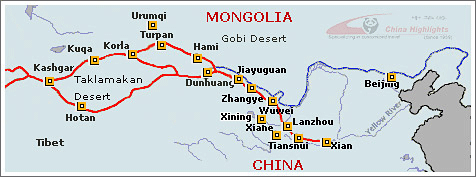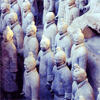Attractions on the Silk Road
Silk Road, is the collective name given to a number of trade routes linking the Chinese and Roman Empires. This ancient route starts from the old capital of Xian, reaches the Yellow River at Lanzhou and then follows along the "Gansu Corridor" and travels along the edge of the deserts and mountains.
Following in the footsteps of the caravans along this ancient trade route, you will pass through numerous cultural relics and historical sites across China's vast west areas.
Silk Road Map

 Click the name of a city to find all the attractions around that area . Click the name of a city to find all the attractions around that area .
Xian
 Xi’an was the starting point of the Silk Road. As one of China’s seven ancient national capitals, it served as the capital for 12 dynasties over 1,000 years. Xi’an is blessed with a great number of precious relics and historical sites. They include the Army of Terra Cotta Warriors (the eighth Wonder of the World), two historical Buddhist Pagodas (Big Wild Goose Pagoda and Small Wild Goose Pagoda), the Great Mosque, the Ancient City Wall, Banpo site and the Stele Fores. Xi’an was the starting point of the Silk Road. As one of China’s seven ancient national capitals, it served as the capital for 12 dynasties over 1,000 years. Xi’an is blessed with a great number of precious relics and historical sites. They include the Army of Terra Cotta Warriors (the eighth Wonder of the World), two historical Buddhist Pagodas (Big Wild Goose Pagoda and Small Wild Goose Pagoda), the Great Mosque, the Ancient City Wall, Banpo site and the Stele Fores.
Xian Attractions List
Lanzhou
 An important stop along the Silk Road, Lanzhou is an ancient city with about 2,000 years of history. It began to flourish after the appearance of the Silk Road but little has happened in Lanzhou since the decline of the Silk Road at the end of the Tang dynasty. Even though it is an industrial city, Lanzhou may provide many pleasant surprises for visitors who venture there. The best attractions include The Green Corridor along Binhe Road, Five Spring Mountain, White Pagoda Mountain, Sun Yat-sen Bridge(Iron Bridge), Waterwheel Garden, and Sculptures of the Mother River. An important stop along the Silk Road, Lanzhou is an ancient city with about 2,000 years of history. It began to flourish after the appearance of the Silk Road but little has happened in Lanzhou since the decline of the Silk Road at the end of the Tang dynasty. Even though it is an industrial city, Lanzhou may provide many pleasant surprises for visitors who venture there. The best attractions include The Green Corridor along Binhe Road, Five Spring Mountain, White Pagoda Mountain, Sun Yat-sen Bridge(Iron Bridge), Waterwheel Garden, and Sculptures of the Mother River.
Lanzhou Attractions list:
Xiahe
 Xiahe is a tiny, bustling town centered in a valley of the Ganan Tibetan Autonomous Prefecture, southwest Gansu, to the southwest of Lanzhou. At three thousand meters above sea level, and surrounded by hilly mountains, this rural haven hugs neighboring Tibet. The town is centered around the famous Labrang Monastery, and nearby the gorgeous Sangke Praire. Xiahe is a tiny, bustling town centered in a valley of the Ganan Tibetan Autonomous Prefecture, southwest Gansu, to the southwest of Lanzhou. At three thousand meters above sea level, and surrounded by hilly mountains, this rural haven hugs neighboring Tibet. The town is centered around the famous Labrang Monastery, and nearby the gorgeous Sangke Praire.
Xiahe Attractions List:
Wuwei
 Wuwei called Liangzhou in the past, was an post on the ancient Silk Road. It is a place of affluence bordering Qilian Mountains to the southwest and Tenggeli Desert in the north. Wuwei called Liangzhou in the past, was an post on the ancient Silk Road. It is a place of affluence bordering Qilian Mountains to the southwest and Tenggeli Desert in the north.
Wuwei is a historical and cultural city. Anicent Liangzhou was a big and flourishing city with crowds of caravans coming and going to the Western Region. Monk Xuanzang once preached Buddhist doctrines here.
Wuwei has many places of interest, such as the Eastern Han Tomb.
Wuwei Attraction List:
Zhangye
Zhangye, a historical city is in the central part of the Hexi Corrior. Nourished by the melting snow from the Qilian Mountains, Zhangye is quite different from the rest of Gansu, which is dry and barren. The area is characterized by lush cultivated fields, vast grassland and its diverse culture.
Attractions:
Jiayuguan
 Named after the well known impregnable passl on the westernmost end of the Great Wall, Jiayuguan city was an important stop on the ancient” Silk Road” and served as a significant trade link between China and the other parts of the world. Its great historical role over years has endowed the place with abundant historical sites and cultural relics including the Jiayuguan Pass, overhanging the Great Wall. Named after the well known impregnable passl on the westernmost end of the Great Wall, Jiayuguan city was an important stop on the ancient” Silk Road” and served as a significant trade link between China and the other parts of the world. Its great historical role over years has endowed the place with abundant historical sites and cultural relics including the Jiayuguan Pass, overhanging the Great Wall.
Attractions:
Dunhuang
 Many foreign visitors know Dunhuang because of the Silk Road passed through it, and as one of China’s most important ancient trading posts. History has endowed the city with abundant historical sites and cultural heritage. Apart from the unrivaled Buddhist carvings in Mogao Grottos, the White Horse Pagoda, the old Yangyuan City and Han Dynasty Beacon Lights are all well worth seeing. Many foreign visitors know Dunhuang because of the Silk Road passed through it, and as one of China’s most important ancient trading posts. History has endowed the city with abundant historical sites and cultural heritage. Apart from the unrivaled Buddhist carvings in Mogao Grottos, the White Horse Pagoda, the old Yangyuan City and Han Dynasty Beacon Lights are all well worth seeing.
Attractions:
Urumqi
 Located at the foot of the snow-capped Tianshan Mountain Range, Urmuqi is the capital of Xinjiang Uygur Autonomous Region in northwest of China. The place became known to foreign visitors mainly for its role as the last stopover along the” Silk Road”. The place has been home to a mix of ethnic groups for nearly 2,000 years and became a heavily guarded fort in the Han Dynasty. Sights in and around Urmuqi are The Southern Pasture, The Erdaoqiao Bazaar, Heavenly Lake and Xinjiang Autonomous Museum. Located at the foot of the snow-capped Tianshan Mountain Range, Urmuqi is the capital of Xinjiang Uygur Autonomous Region in northwest of China. The place became known to foreign visitors mainly for its role as the last stopover along the” Silk Road”. The place has been home to a mix of ethnic groups for nearly 2,000 years and became a heavily guarded fort in the Han Dynasty. Sights in and around Urmuqi are The Southern Pasture, The Erdaoqiao Bazaar, Heavenly Lake and Xinjiang Autonomous Museum.
Attractions:
Turpan
 Turpan in the Uygur language means red rocks, and got its name from the dark red sandstone dominating the area. Despite its harsh conditions Turpan is nationally known for its grapes, cantaloupe and sun dried raisins. Popular sights here are Gaochang Ancient City, the Astana Tombs, and the Flaming Mountain. Turpan in the Uygur language means red rocks, and got its name from the dark red sandstone dominating the area. Despite its harsh conditions Turpan is nationally known for its grapes, cantaloupe and sun dried raisins. Popular sights here are Gaochang Ancient City, the Astana Tombs, and the Flaming Mountain.
Attractions:
Korla
 Korla is 471 kilometers north of Urumqi and is a center of transportation for the Southern Region to Urumqi and China's inner provinces. Travelers can fly over or drive through the vast Taklimakan desert to the city. Korla served as an important outfitting station on the Silk Road. Korla is 471 kilometers north of Urumqi and is a center of transportation for the Southern Region to Urumqi and China's inner provinces. Travelers can fly over or drive through the vast Taklimakan desert to the city. Korla served as an important outfitting station on the Silk Road.
Attractions:
Kuqa
 Kuqa in the central part of the Xinjiang Uygur Autonomous Region, in the middle of the northern section of Tarim Basin and was is a famous city on the Silk Road and was the center of Buddhism in the Western Regions after the Northern and Southern Dynasties. The city was culturally prosperous during the Tang Dynasty. Kuqa in the central part of the Xinjiang Uygur Autonomous Region, in the middle of the northern section of Tarim Basin and was is a famous city on the Silk Road and was the center of Buddhism in the Western Regions after the Northern and Southern Dynasties. The city was culturally prosperous during the Tang Dynasty.
Attractions:
Hotan
 Hotan has remained famous for centuries for its jade, silk and carpets. Located on the southern rim of the Taklimakan Desert, it is a place where the state of Pishan, Yutian, and Jingjue were established. There are historic sites and various unearthed cultural relics in Hotan. Hotan has remained famous for centuries for its jade, silk and carpets. Located on the southern rim of the Taklimakan Desert, it is a place where the state of Pishan, Yutian, and Jingjue were established. There are historic sites and various unearthed cultural relics in Hotan.
Attractions:
Kashgar
 Kashgar is China’s Muslim center. It used to be an important stop on the centuries-old Silk Road, and trade remains timeless still in this vibrant oasis, at least on Sundays, when the bustling markets are packed with uniquely dressed Uygurs, ambitious Central Asian traders and veiled Muslim women. Main attractions include Id Kah Mosque, The Abakh Khoja Tomb, Sunday Bazaar, Karakul Lake and so on. Kashgar is China’s Muslim center. It used to be an important stop on the centuries-old Silk Road, and trade remains timeless still in this vibrant oasis, at least on Sundays, when the bustling markets are packed with uniquely dressed Uygurs, ambitious Central Asian traders and veiled Muslim women. Main attractions include Id Kah Mosque, The Abakh Khoja Tomb, Sunday Bazaar, Karakul Lake and so on.
Attractions:
Xining
 Xining was once an important stop on the centuries old Silk Road. The boom of the Silk Road in the Han Dynasty is a major factor for the city’s rise. But the city’s historical role gradually declined as the trade route fell into disuse. Xining’s importance in the old trade route means that it has a lot of historical sites. Xining was once an important stop on the centuries old Silk Road. The boom of the Silk Road in the Han Dynasty is a major factor for the city’s rise. But the city’s historical role gradually declined as the trade route fell into disuse. Xining’s importance in the old trade route means that it has a lot of historical sites.
Attractions:
|
|